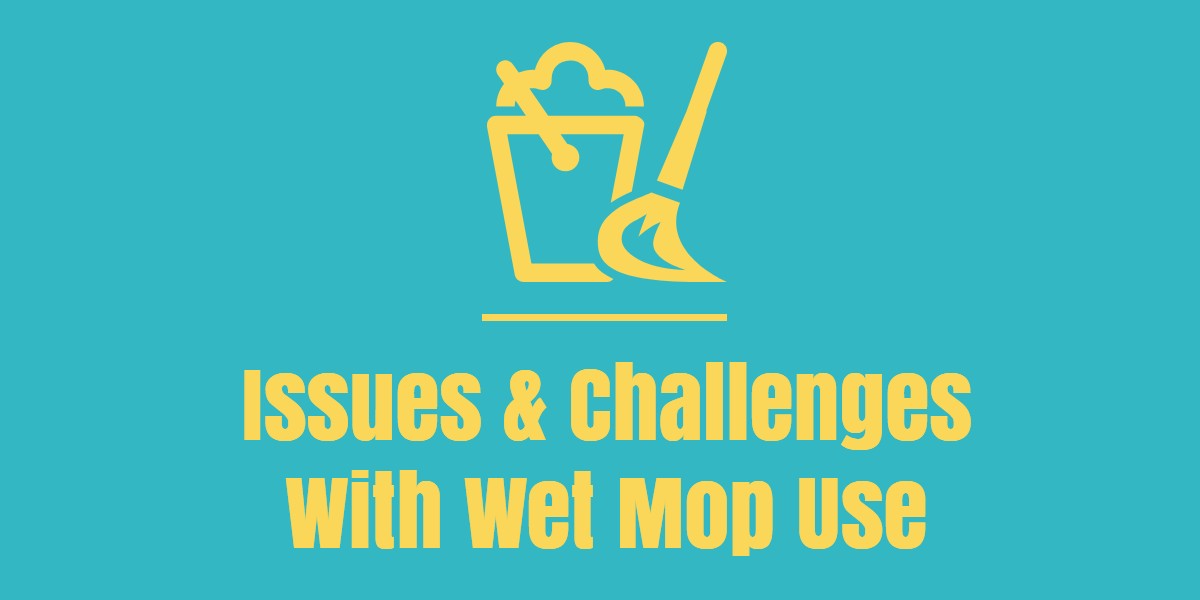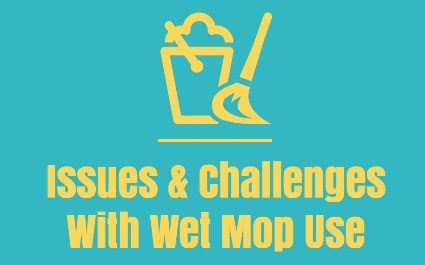The use of wet mops presents several challenges for schools and businesses concerned with the spread of germs.

Confronting the Issues of Wet Mop Use
Wet mops–a mainstay of home, school, and office cleaning for decades–are an outdated apparatus that have been shown to contribute to health and safety issues after the very first use, a fact that has been documented since at least 1971.
Following the demonstration of massive spread of bacterial contamination throughout the hospital by the wet-mopping techniques in use, quantitative studies were undertaken to determine the source of contamination and to institute measures of control.
It was found that mops, stored wet, supported bacterial growth to very high levels and could not be adequately decontaminated by chemical disinfection.
Laundering and adequate drying provided effective decontamination, but build-up of bacterial counts occurred if mops were not changed daily or if disinfectant was omitted from the wash-water.
Hospital sanitation: the massive bacterial contamination of the wet mop
Additional areas of concern, regarding the use of wet mopping, is the cleanliness of the buckets, which can harbor germs and bacteria growth without regular cleaning, and can contribute to the floor being filthier and more germ-ridden after it was ‘cleaned.’
[…] the tools many facilities use to clean floors—mops and buckets—are key culprits in spreading bacteria.
In fact, in some cases, the floor was actually more infested with bacteria after the floor had been mopped.
The mop head tested was found to contain more than eight million bacteria per 100 cm2.
Wet Mop Challenges
Wet mopping combined with single-bucket use has its usefulness–specifically, cleaning up spills.
However, it falls short when the time comes to sanitize hard floors.
- Large, cotton-string mop heads are bulky and can be difficult and expensive to clean, disinfect, and dry after each use.
- Single-bucket use can lead to cross-contamination issues and the spread of germs if the buckets are not scrubbed out after each cleaning cycle, per area.
- Additionally, hot water use can increase the rate of growth and spread of germs and bacteria within the bucket.
- Maintaining and storing the number of conventional cotton-string mops necessary to thoroughly clean and sanitize an entire facility is not cost-effective or practical for most organizations.
- Additionally, cleaning or switching out the single bucket after the restroom floor is sanitized to avoid cross-contamination with a dining or food preparation floor is entirely impractical.
Green Cleaning Solutions
To address the challenges associated with conventional cotton-string, cloth, or sponge mops, as well as the issues of resource waste and surface cross-contamination:
- Switch to color-coded microfiber mops with easily detachable heads. This simplifies the task of maintenance, increasing the likelihood of compliance, and reduces the spread of germs and bacteria.
- Purchase dual-bucket systems that allow for the wringing out of the microfiber mop head on one side, and the storage of the cleaning or disinfecting product on the other. This reduces the potential for contaminating the cleaning product and drastically reducing its effectiveness.
- To simplify the management of your organization’s floor mopping program, ensure the buckets are color-coded to match the mop heads, and document what floor or area each color is intended to service, thereby eliminating the potential for surface cross-contamination.
- Make sure to regularly rinse and clean the buckets to avoid the buildup of germs and bacteria. Additionally, consider drying the buckets with a microfiber cloth after emptying to further forestall the growth.
- Switch to certified green cleaning floor products and disinfectants, which do not require the use of hot water, which can speed along the development and likely spread of harmful bacteria.
This method has proven its worth and cost-effectiveness in facilities ranging from health care to education, and office buildings of every type.
References & Resources
- Remove Germs, Don’t Spread Them
- 5 Ways to Smarter Mopping
- Causes And Prevention Of Slips And Falls
- Floor Cleaning Eye-Opener
- Do Mops Spread Disease?
Takeaway
Cotton-string mops have been shown, over the course of several decades, to create more of a mess than they clean.
Despite their notable utility in cleaning up spills, the number of germs and bacteria that are facilitated and spread via their use renders them highly undesirable in modern office and educational facilities.
Adding to the pressure of switching to more cost-effective microfiber and green cleaning solutions is the ongoing and increasing cost of necessary maintenance.
Conversely, color-coded microfiber mop heads and dual-bucket systems provide a demonstrated improvement in germ and bacteria reduction and a reduced total cost of ownership.
If you would like to learn more about the benefits of microfiber use and green cleaning practices for your school or business–contact us today for a free quote!
In Bakersfield CA, call (661) 4373253
In Fresno CA, call (559) 206-1059
In Valencia CA, or Santa Clarita CA, call (661) 437-3253

